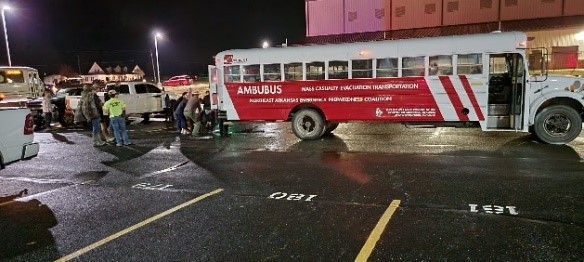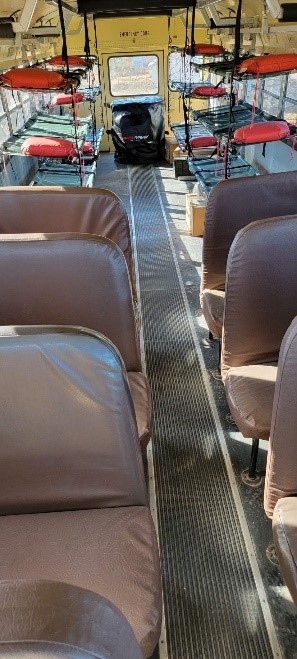Mass Evacuation Training Prepares Northeast Arkansas Health Care Coalition to Rescue Nursing Home Residents in the Path of Devastating Tornadoes
Northeast Arkansas
December 2021
Background
Emergency response simulations and surge trainings are key to a successful response during a real-life emergency. In June 2021, the Northeast Arkansas Office of Preparedness & Emergency Response Systems, a Northeast Arkansas health care coalition (HCC) established through ASPR's Hospital Preparedness Program (HPP), held a mass surge simulation event for a nursing home facility instead of a hospital. Little did they know that this simulation would mirror the HCC's real-life response to tornadoes that ripped across Arkansas just months later in December 2021.
Impact
The funding administered through ASPR's HPP and the cooperative agreement's coalition exercise requirement equipped the Northeast Arkansas Office of Preparedness & Emergency Response Systems with the resources and knowledge necessary to lead the tornado response.
|
“Without [ASPR] funding, there wouldn't have been a response from our side. The Readiness [and] Response Coordinator wouldn't have been there, and we would've had a much harder time evacuating the stretcher patients and nursing home facilities."
-
T.L. Davis,
Readiness and Response Coordinator for the Northeast Arkansas Office of Preparedness & Emergency Response Systems
|
This HCC was well-prepared to respond to this situation, ensuring its members had a plan in place to effectively coordinate with response partners to rescue, treat, and care for the 36 patients affected by the tornadoes. Only days after the initial response, HCC members debriefed with emergency response and health care partners to identify solutions to gaps uncovered by the recent response. The Northeast Arkansas Office of Preparedness & Emergency Response Systems’ efforts are a real-world example of how HCCs not only support preparedness and response, but also facilitate continuous improvement after an emergency has subsided.
Response Activities:
 While there, the Readiness and Response Coordinator for the Northeast Arkansas Office of Preparedness & Emergency Response Systems took charge of response efforts for the coalition, facilitating communication between hospitals, first responders, and Response Systems took charge of response efforts for the coalition, facilitating communication between hospitals, first responders, and the EOC.
While there, the Readiness and Response Coordinator for the Northeast Arkansas Office of Preparedness & Emergency Response Systems took charge of response efforts for the coalition, facilitating communication between hospitals, first responders, and Response Systems took charge of response efforts for the coalition, facilitating communication between hospitals, first responders, and the EOC.
 After organizing a response plan, coalition leaders drove the AMBUBUS toward the destruction at Quail Run Nursing Home in Trumann, Arkansas, only to find the road blocked by rubble and downed power lines. Firefighters cut power lines, allowing the AMBUBUS to reach the nursing home and safely transport all 36 patients back to the triage site for treatment and relocation. Before transporting patients from Quail Run, other coalition members transported an additional 67 residents out of Monette Manor Nursing Home facility, which was leveled by an F4 tornado, ensuring that those individuals received necessary care. Within eight hours of the response, all displaced nursing home residents were treated for any injuries and relocated to new facilities.
After organizing a response plan, coalition leaders drove the AMBUBUS toward the destruction at Quail Run Nursing Home in Trumann, Arkansas, only to find the road blocked by rubble and downed power lines. Firefighters cut power lines, allowing the AMBUBUS to reach the nursing home and safely transport all 36 patients back to the triage site for treatment and relocation. Before transporting patients from Quail Run, other coalition members transported an additional 67 residents out of Monette Manor Nursing Home facility, which was leveled by an F4 tornado, ensuring that those individuals received necessary care. Within eight hours of the response, all displaced nursing home residents were treated for any injuries and relocated to new facilities.

